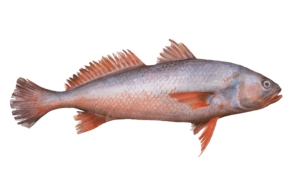Acoupa weakfish facts for kids
Quick facts for kids Acoupa weakfish |
|
|---|---|
 |
|
| Conservation status | |
| Scientific classification | |
| Synonyms | |
|
The acoupa weakfish (scientific name: Cynoscion acoupa) is a cool type of ray-finned fish. It's also known as the blacktail basher or grey snapper. This fish belongs to the family Sciaenidae, which includes many "drums" and "croakers." You can find them swimming in the western part of the Atlantic Ocean.
Contents
What's in a Name?
Every living thing has a scientific name, like a special code. The acoupa weakfish was first described in 1801. A French scientist named Bernard Germain de Lacépède gave it the name Cheilodipterus acoupa. He found it near Cayenne in French Guiana.
Today, this fish is part of the Cynoscion group. This group is placed within the Sciaenidae family. This family includes many fish known for making drumming or croaking sounds.
What Does It Look Like?
Body Shape and Size
The acoupa weakfish has a long, torpedo-shaped body. It's a bit flattened from side to side, making it look oval when you view it head-on. Its head is low, and its eyes are a medium size. It has a large mouth that opens upwards.
This fish can grow quite big! The largest recorded acoupa weakfish was about 110 centimeters (43 inches) long. That's over 3.5 feet! However, most of them are around 45 centimeters (18 inches) long. The heaviest one ever found weighed about 17 kilograms (37 pounds).
Teeth and Fins
The acoupa weakfish has many rows of tiny teeth. It also has two large, pointy, fang-like teeth at the front of its upper jaw. The teeth in its lower jaw get bigger towards the back.
It has a long dorsal fin on its back. This fin has 10 stiff spines at the front. Behind these, it has one more spine and 17 to 22 soft rays. The anal fin on its underside has 2 small spines and 7 to 9 soft rays.
Scales and Color
This fish has large scales covering its body. The scales on its body are rough (ctenoid), while those on its head are smooth (cycloid). A special line, called the lateral line, runs along its side. This line helps the fish sense movements in the water. It goes all the way to the middle of its tail fin.
The acoupa weakfish is silver in color. It has pale yellowish-orange areas. You might see darker spots along the base of its dorsal fin. Its tail, pelvic, and pectoral fins are a darker yellowish-orange than its body.
Where Does It Live?
Ocean Home
The acoupa weakfish lives in the western part of the Atlantic Ocean. You can find it from Lake Maracaibo in Venezuela all the way down to southern Brazil. Some reports say it's also in the Gulf of Venezuela and near the coasts of Colombia and Panama. However, these sightings need to be confirmed.
Preferred Places
This fish likes shallow coastal waters. It often hangs out near estuaries, which are places where rivers meet the sea. It prefers sandy or muddy bottoms. You can find it in waters up to 45 meters (148 feet) deep. Interestingly, it can even swim into freshwater!
How Does It Live?
Life Cycle
The acoupa weakfish lays eggs, which means it is oviparous. They gather in large groups in estuaries to lay their eggs. These estuaries also serve as safe "nurseries" for the young fish.
Adult fish usually stay in shallow coastal waters near estuaries. However, the younger fish, called juveniles, will often swim into freshwater.
Daily Habits
These fish are not very active during the day. But when night comes, they become busy hunters! They search for smaller fish and shrimp to eat.
Why Is This Fish Important to People?
Food and Trade
The acoupa weakfish is a popular fish for both commercial and local fishing. People really like to eat it in places like French Guiana and Guyana.
Its swim bladder (an organ that helps fish float) is also very valuable. It's traded around the world, especially in China. People believe it has special health benefits. The swim bladder is also used to make isinglass, a substance used in some foods and drinks.
Challenges
Because the swim bladder is so valuable, there has been an increase in illegal fishing for this species. This makes it harder to protect the fish.
Is It in Danger?
Conservation Status
The acoupa weakfish is highly valued for its meat and its swim bladder. It also gathers in large, predictable groups, which makes it easy to catch. These things make it vulnerable to being overfished.
There is evidence that too many of these fish are being caught. Fishermen are catching fewer fish, even with more effort. This, along with a lack of strong protection and ongoing illegal fishing, has led the IUCN (International Union for Conservation of Nature) to classify this species as Vulnerable. This means it's at risk of becoming endangered if things don't change.


